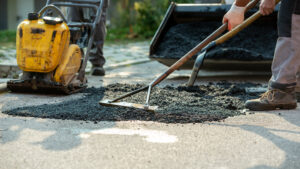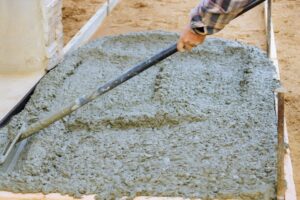How To Temporarily Repair Cracks In Concrete Driveway
If you have a concrete driveway, then sooner or later you are going to have to deal with cracks. While they can be unsightly, they’re not usually a major problem. There are quite a few various ways to repair the cracks: utilize various compounds or fillers and follow the repair steps with timeliness.
Before you fix cracks in a driveway, it’s helpful to understand the different types of compounds available. Because there are so many choices, make sure to read the labels before making a selection.
Types Of Compounds
- Ready-Mix: The first type is ready-mix concrete patching compound, which is made from Portland cement and aggregate such as fine sand or stone dust. It’s relatively easy to use, and it dries quickly so you can get on with your day. However, it does have a few downsides: it’s not very durable, and it can be a bit on the expensive side.
- Asphalt Patching: The next type of compound is asphalt patching material. This is a black gooey substance that’s used to fix nicks and potholes. It consists of a binder, which holds the asphalt together, and aggregates such as stone dust or sand. This mixture is toxic when wet, so don’t forget to wear gloves and protective glasses. You can apply it with a trowel or by spraying the area first with water. Finally, you can spread the asphalt patching material over the area with a squeegee.
- Epoxy: The final type of compound is epoxy. Epoxy is a two-part system that cures to form a very hard, durable surface. It’s perfect for fixing cracks in driveways, and it comes in a variety of colors so you can find the perfect match for your home. However, epoxy is also the most expensive option of the three.
Repairing cracks in a concrete driveway is not a difficult task, but it does require some patience and careful attention to detail. By following these steps, you can have your driveway looking good as new in no time!
Steps To Repair Cracks
If your concrete driveway has a few small cracks, you can temporarily fix them yourself using a concrete patching compound.
1. Clean the crack up thoroughly before beginning repairs. This includes removing all of the loose material and cleaning the exposed edges. It is helpful to clean the cracks with a wire brush or stiff-bristled brush. This will remove the dirt and debris for a better repair. Once it has dried, wipe over the exposed surface with a wire brush to remove all of the dirt or grime that is present.
2.. Mix a small amount of patching compound in a plastic bucket using a putty knife. Add water to create a thick, putty-like consistency. Apply masonry adhesive to both sides of the crack, making sure to use only as much as you need
3. Press on some fiberglass mesh fabric (or other reinforcement material) into the adhesive, making sure to press it firmly into place.
4. Use a trowel with an edge that’s flat on one side and angled on the other to apply the compound. Pack the cracks tightly with the trowel, being careful not to slop mortar onto other parts of the driveway. Wipe away any excess compound using a damp cloth before it dries completely.
5. Allow the adhesive to dry completely before applying a coat of sealant.
6. Apply a coat of sealant to the crack, using a brush or roller. Be sure to get into all of the nooks and crannies, and make sure it gets below the level of the surrounding concrete.
7. Cover each repaired area with painter’s tape and wait for two or three days for the mortar to set.
8. Allow drying completely before walking or driving on the driveway. If you need to apply more sealant, allow it to dry for at least 24 hours before doing so. If the repaired area is still a little rough, skim over it with a piece of 100-grit sandpaper and wipe away any dust before applying the second coat of mortar.
9. After 24 hours, apply your favorite concrete color using an airless sprayer*. Be sure to use a light, even coat, and work it into the pavement as much as possible. This will help to hide the cracks from sight.
10. Spray the entire driveway with clean water to remove any dirt residue from the repair job and let it dry completely before driving on it. Allow drying completely before driving or walking on the new paint over.
In recent times, homeowners are exploring alternative methods to address issues with their driveways and sidewalks. One such effective technique is mudjacking a sidewalk. This process involves injecting a mixture of soil, water, and cement beneath the sidewalk to raise it back to its original level. It’s particularly useful when the concrete slabs have sunk due to soil erosion or other underlying problems.
Not only is mudjacking a cost-effective solution, but it also reduces the need for a complete replacement, making it an eco-friendly option. If you’ve noticed uneven surfaces around your property, it might be worth considering this method before jumping into more extensive repairs.
*Note: If you’d prefer not to paint your driveway, you can use a concrete stain instead of a sealer.
There are a few different ways to fill the cracks in your driveway. You can use a concrete patching compound, asphalt patching compound, or a sealant.
 Patching Variants
Patching Variants
There are various pros and cons of different compounds. From the lasting duration to price point to time to dry to the colors, you can choose the best option based on the reasons below:
- Color – Concrete and asphalt patching compounds come in a variety of colors, so you can choose one that will match the color of your driveway. Sealants come in clear or a variety of colors, but you can use them on any type of surface.
- Long-Lasting- Concrete and asphalt patching compounds are easy to apply, but they won’t last as long as a sealant. Concrete and asphalt patching compounds will wear away from cars driving over them or from foot traffic. Sealants last much longer than concrete and asphalt patching compounds, but they are harder to apply.
- Cost – Concrete and asphalt patching compounds are fairly inexpensive, so you won’t have to worry about spending a lot of money on them. Sealants can cost more than concrete or asphalt patching compounds because they will last longer. If you’re concerned about the appearance of your driveway, you might want to use a sealant.
- Drying Duration – Concrete and asphalt patching compounds and sealants will dry within a couple of hours after you apply them, but they aren’t completely hard for at least 24 hours. You should wait at least 24 hours before driving on your patched driveway or walking across it. If you’re applying the patching compound or sealant in cold weather, you might have to wait a little longer for it to dry. Concrete and asphalt patching compounds are available at your local hardware store, while sealants can be found at home improvement stores or online.
Why Is It Important To Fill The Cracks?
It’s important to fill the cracks in your driveway because they can cause problems with your driveway’s surface. Filling the cracks will help prevent water from getting into the cracks and freezing, which can cause the driveway to crack or even break.
Filling the cracks in your driveway is a quick and easy way to improve the appearance and longevity of your driveway. It’s a task that anyone can do, so don’t hesitate to pick up a patching compound or sealant to fix your driveway’s cracks.
There are two ways to fill the cracks that emerge in your concrete driveway or sidewalk. You can use a self-leveling sealer or you can purchase crack filler material and mix it with water. Which method is better? That all depends on what you’re looking for.
Sealers vs. Fillers
- Sealers–
- Self-leveling sealers are a quick and easy way of filling the cracks of your driveway, whether they be hairline cracks or wide fissures. Basically what a self-leveling sealer does is fill in all the pores in between the cement particles to form an air-tight seal. These sealers are great for filling cracks in your sidewalk, patio, and basement flooring. They will not however create a smooth, level surface that is easily walked upon. Cracks must be filled with something else if you desire to have an even surface after the job is completed.
- Self-leveling sealers are also rather expensive; the sealers themselves are more costly than crack filler material and it takes many layers of sealer to cover a new driveway. With that said, sealers will leave your driveway with an attractive, smooth appearance which some people prefer.
- Fillers–
- When choosing a filler, always make sure to read the directions first and test an inconspicuous spot before starting your project. It’s not a bad idea to try out both types of the product either and see which one will look the best in your situation.
- For those who would like an even surface after applying their re-fill crack filling products, there are two basic types of material: those that harden and those that stay flexible. The hardening products are made to shrink and fill the void as they dry, so there is no movement after the application. The problem with this type is that over time the concrete can crack around the filler material as it dries, requiring another application. This defeats the purpose of trying to fix your concrete, rather than filling it.
- The other type of material is the flexible kind which has a bit more give to it. These are best for cracks that are 2″ or less in width. This is because they will continually move with the changing of temperatures and allow you to avoid any future cracking problems by having more flexibility built into the filler material.


